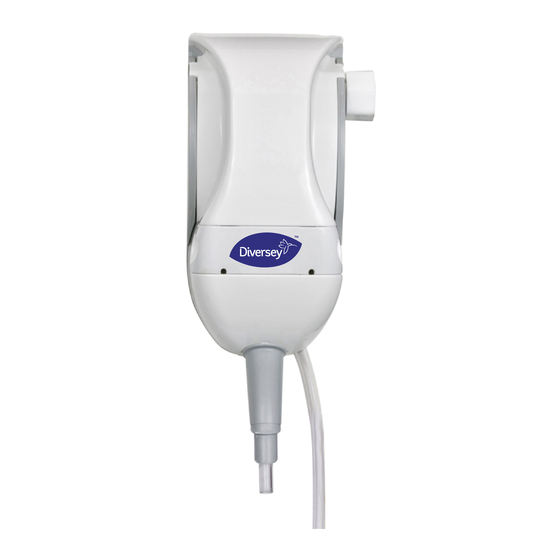
Table of Contents
Advertisement
Advertisement
Table of Contents

Subscribe to Our Youtube Channel
Summary of Contents for diversey QFM
- Page 1 Installation & Setup Guide Page 1 of 11 DE1548 INT issB s1 July 2012...
-
Page 2: Table Of Contents
Installation & Setup Guide Contents Description Page Safety …………………………………………………….………………. Installation Standards …………………………………………… Specifications ……………………………………………………………. Installation …………………………………………………………………. Removing the front cover…………………………………………… Releasing Proportioner…………………………………………….. Fixing the unit to the wall…………………………………………… Connecting water supply ………………………………………….. Connecting tubing…………………………………………………… High flow …………………………………………………………….. Low flow ……………………………………………………………… Fixing Anti-Foam tube ………………………………………………... -
Page 3: Safety
Installation Open the QFM by inserting the “C”- shaped steel clip into the front cover then lift cover upward. The cover will only come away completely from the backplate when it is pulled up by an angle of 45°. (Fig 1.1) Hinge Fig 1.1... -
Page 4: Removing The
Clip Fig. 1.3 Position the QFM vertically on the wall and drill three holes for either the horizontal mounting slots or the keyholes. Use the horizontal mounting slots for hard-plumbed installations as they allow the unit to slide 25mm from side to side when connecting or disconnecting from the water fitting. Use the keyholes when using a flexible water supply line. - Page 5 Installation & Setup Guide Pull outward the blue plastic retaining clips on the far left and far right (Fig 1.5). NOTE: The clips do not require to be fully pulled out.They are designed to be permanently connected to the valve to avoid misplacement. Fig 1.5 Pull water inlet fitting out of the right side and the plug from the left side, reinserting them in the opposite ends.
-
Page 6: Connecting Tubing
Installation & Setup Guide Connecting Tubing High Flow Connect the discharge tube to the large barb, (Fig 1.7) and secure onto barb with tie wrap. Attach the Pick-up tube. Secure discharge tube onto barb with tie wrap. Attach Pick-up tube. Fig 1.7 Low Flow NOTE: The anti foam tube is only required on Low Flow Air Gap version. -
Page 7: Fixing Anti-Foam Tube
Installation & Setup Guide Squeeze clamp Tiewrap. to secure. Anti-foam Tube. Bottle Fill Tube. Attach anti-foam tube to Ensure Anti-Foam tube Attach the Bottle Fill spigot on the end of the is securely fixed with Tube using the supplied eductor. clamp provided. -
Page 8: Inserting Metering Peg
Installation & Setup Guide CAUTION: When attaching the pick-up tube, a longer tube may be required than supplied. If a longer tube is required ensure that the inside diameter is no smaller than 6mm and should ideally be 10mm, especially if the product is viscous. A 6/10mm adapter is available from JDE for this purpose. -
Page 9: Setup
Installation & Setup Guide Setup Select the metering peg that offers the desired dilution, using the following chart for reference. Place the letter that is the desired setting at the bottom, where the index pin holds the metering peg in place. Actual ratios and flow rates will vary depending on water pressure, chemical viscosity, the length of the pickup line, the height of the unit from the floor and the level of product in the drum. -
Page 10: Changing From Momentary "Hold On" To "Lock On
Check operation by re-assembling the wishbone and checking the state of the valve when activated. • Replace cover, turn on water and check operation. Dilutions with QFM for various viscosity products Dilutions with QFM for various viscosity products Thick product (washing up liquid) (>700cp) Thick product (washing up liquid) (>700cp) - Page 11 Installation & Setup Guide Chart showing dilution variation due to water pressure on site Chart showing dilution variation due to water presure on site 25.0 20.0 15.0 10.0 Recommended Min Recommended Max Recommended Recommended Min Pressure Pressure Pressure Max Pressure Water Pressure on site (flowing) Water Pressure on site (flowing) NOTE: Both charts are with channel A plug setting and are for illustration purposes only.




Need help?
Do you have a question about the QFM and is the answer not in the manual?
Questions and answers